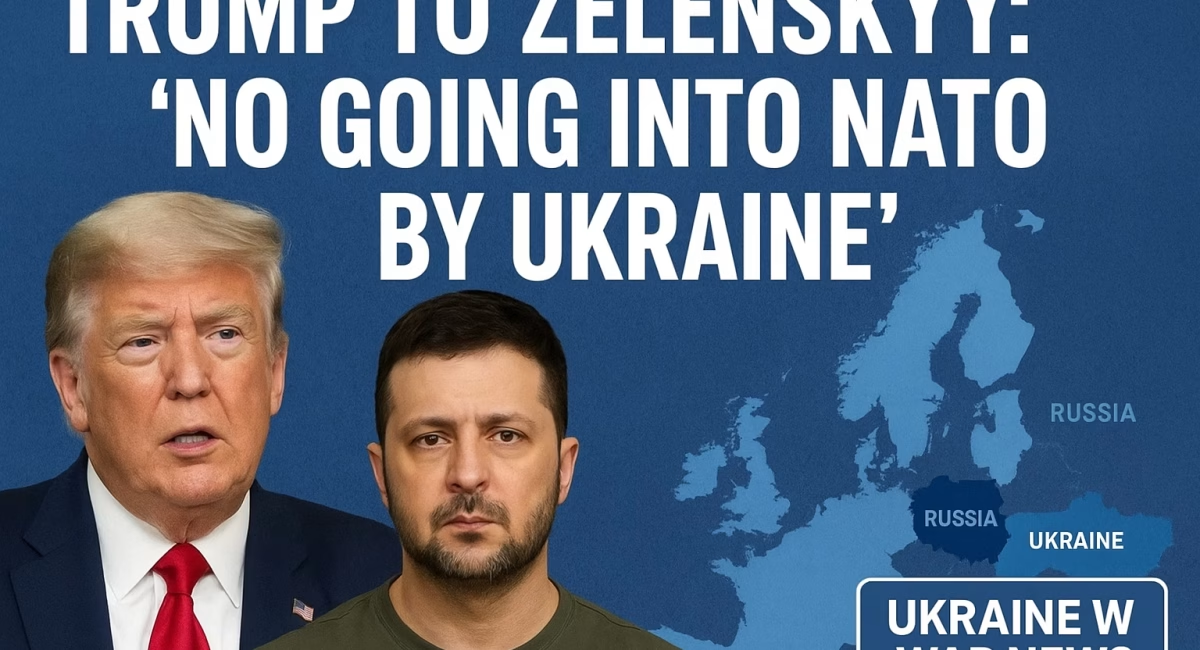“No NATO” and America’s Big Question
At their Washington summit, Donald Trump made it clear to Volodymyr Zelenskyy — Ukraine won’t be joining NATO. As the Ukraine–Russia war enters another tense phase, U.S. politics is once again at the center of global attention. Ahead of a critical meeting in Washington, President Donald Trump issued a blunt message to Ukrainian President Volodymyr Zelenskyy:
“No going into NATO by Ukraine.”
This statement has raised sharp debates in the United States—about foreign aid, NATO expansion, and America’s role in ending the war. With European leaders rallying behind Ukraine, the White House summit is shaping up to be a turning point not only for Kyiv but for U.S. foreign policy itself.
1. Trump’s Ultimatum: “No NATO for Ukraine”
- On his social platform, Trump declared Ukraine could end the war “almost immediately” if it dropped its NATO ambitions and agreed to concessions.
- Trump’s stance reflects a long-standing Russian demand: no NATO membership for Ukraine.
- He also hinted at possible “Article-5-like” security guarantees for Ukraine, negotiated with Putin at their recent Alaska meeting.
2. Zelensky’s Response and European Support
- Zelensky has rejected any territorial concessions and insists Ukraine’s sovereignty cannot be negotiated.
- He arrived in Washington backed by top European leaders—including Emmanuel Macron, Giorgia Meloni, Keir Starmer, and Ursula von der Leyen—to present a united front.
- Their goal: push back against any U.S.–Russia deal that undermines Ukraine’s independence.
3. NATO and Ukraine: Why It Matters for Americans
- NATO explained for U.S. readers: NATO (North Atlantic Treaty Organization) is a defense pact that guarantees collective security.
- If Ukraine joined NATO, any Russian attack could trigger U.S. military involvement under Article 5.
- For many Americans, this raises concerns about direct U.S. military entanglement in Europe.
4. U.S. Politics: Republicans vs. Democrats on Ukraine
- A Pew Research poll (Feb 2025) shows 47% of Republicans believe the U.S. gives “too much” aid to Ukraine, compared to only 14% of Democrats.
- Trump’s “No NATO” position reflects this Republican skepticism about unlimited support.
- Democrats, including President Biden and allies, argue U.S. support protects democracy and deters Russia.
- Public opinion is split: some see Ukraine aid as defending freedom, others see it as costly “foreign entanglement.”
5. The Stakes for America
- Taxpayer dollars: The U.S. has already committed tens of billions in aid. Many ask if this money should be spent domestically instead.
- Global influence: If the U.S. backs away, Russia could strengthen its power in Europe—and China may see it as a signal in the Taiwan conflict.
- NATO credibility: Dropping Ukraine’s NATO bid could weaken alliance deterrence, raising fears in Poland and the Baltic states.
6. What Happens Next?
- Trump and Zelensky’s Washington meeting will test whether a peace framework is possible.
- If Trump pushes for a deal without NATO membership, the outcome could reshape America’s global leadership for decades.
- For everyday Americans, the debate centers on a bigger question: Should the U.S. continue as the world’s “policeman” or focus inward?
FAQs
Q1. What did Trump say to Zelensky about NATO?
Trump stated clearly: “No going into NATO by Ukraine” and claimed this could end the war almost immediately.
Q2. Will Ukraine join NATO in 2025?
As of now, Ukraine’s NATO membership is blocked by both Russia’s demands and Trump’s opposition. Zelenskyy insists Ukraine needs strong security guarantees.
Q3. How much U.S. aid has gone to Ukraine?
Since 2022, the U.S. has provided over $75 billion in military and economic aid, sparking debate among taxpayers.
Q4. What do Americans think about U.S. support for Ukraine?
According to Pew, 30% of Americans believe the U.S. is giving too much support, while 22% believe it’s not enough. Republican voters are far more skeptical than Democrats.
Q5. Why is NATO expansion controversial in the USA?
NATO expansion raises the risk of U.S. troops being drawn into direct conflict with Russia—something many Americans worry about.
Conclusion
The Trump–Zelenskyy Washington summit is more than a diplomatic meeting—it’s a defining moment for America’s foreign policy. With Trump pushing “No NATO,” Zelenskyy demanding guarantees, and Europe standing firm, the outcome will directly shape U.S. strategy, taxpayer spending, and the global balance of power.





